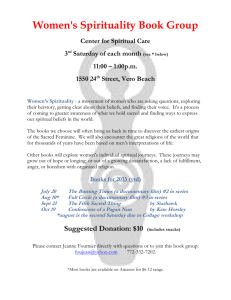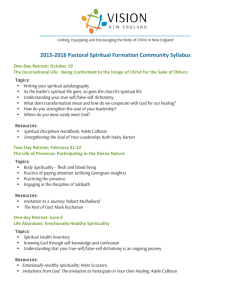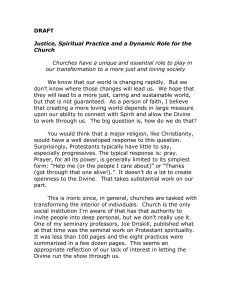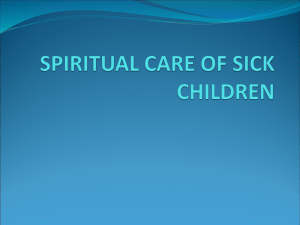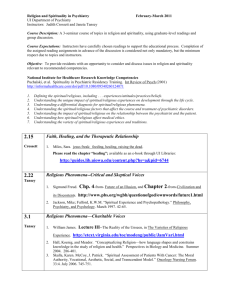Religion and Spirituality in Healthcare Settings
advertisement
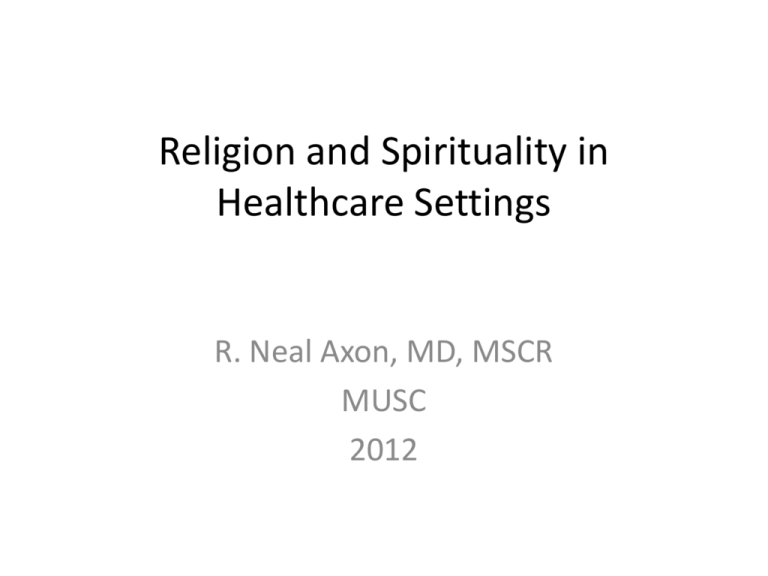
Religion and Spirituality in Healthcare Settings R. Neal Axon, MD, MSCR MUSC 2012 Demand for Religious and Spiritual Support? • Williams JA, et al. Attention to inpatients religious and spiritual concerns. J Gen Int Med. 2011;11:1265. – 41% of inpatients desired a discussion of their religious or spiritual concerns while hospitalized – Only half received such discussions – Patients who had discussions of their R/S concerns had higher patient satisfaction Learning Objectives • Knowledge – Summarize results of empiric research on the effect of religion, spirituality, and prayer on health outcomes. – Recognize common health beliefs causing confusion and/or conflict in healthcare settings. • Skills – Demonstrate how to obtain a spiritual history using the "FICA" method. – Discuss strategies for managing conflicts that arise between patients/families and healthcare providers over religion and spirituality. • Attitudes – Attach value to the role that religion and spirituality play important patients' coping with and recovery from illness. – Approach issues of religion and spirituality with heightened sensitivity. Module 1: Evidence Evidence for Spirituality Effects (1) • Some studies show that regular religious attendance is inversely proportional to mortality – Chida Y, Steptoe A, Powell L. Religiosity/spirituality and mortality. A systematic quantitative review. Psychother Psychosom. 2009; 78(2):81-90 • Religiosity/spirituality may have a favorable effect on survival. – Williams D, Sternthal M. Spirituality, religion and health: evidence and research directions. Med J Aust. 2007; 187(7):421 • Taking a spiritual history indicates to the patients that the physician is concerned with the whole patient. – D’Souza R. The importance of spirituality in medicine and its application to clinical practice. Med J Aust. 2007; 186(10 Suppl):S57-9 Evidence for Spirituality Effects (2) • What has the science shown regarding the effects of prayer? – 4 possible mechanisms by which prayer can improve health: relaxation, positive emotion, placebo, supernatural intervention • Jantos M, Kiat H. Prayer as medicine: how much have we learned? Med J Aust. 2007; 186(10 Suppl):S51-3 Evidence for Spirituality Effects (3) • What has the science shown regarding the effects of prayer? – Prayer as an adjuvant treatment: • In one study: CCU course score was lower in the prayer group than the usual care group. LOS were not different. • Harris W et al. A randomized, controlled trial of the effects of remote, intercessory prayer on outcomes in patients admitted to the coronary care unit. Arch Intern Med. 1999; 159(19):2273-8. – Overall review article showed no benefit to intercessory prayer. • Roberts L et al. Intercessory prayer for the alleviation of ill health. The Cochrane Collaboration. The Cochrane Library. 2011. Can a physician be spiritually neutral? • Physicians should remain spiritually neutral: – Scheurich N. Reconsidering spirituality and medicine. Acad Med. 2003; 78:356-360. • It is not possible for physicians to remain spiritually neutral: – Hall D, Curlin F. Can physicians’ care be neutral regarding religion? Acad Med. 2004; 29.677-79. Discussion Questions • How should physicians assess the spiritual needs of their patients? • Is it OK for doctors to pray with their patients? If so, under what circumstances? • What have been your experiences with physician/patient prayer? How to obtain a spiritual history • FICA – F = Is faith in God important to you? – I = What impact does your faith have on your life? – C = How important is your faith community to you? – A = How can I can assist you? Guidelines for providing respectful spiritual care 1. 2. 3. 4. 5. Health care professionals should seek a basic understanding of patients’ spiritual needs, resources, and preferences Health care professionals should follow the patient’s expressed wishes regarding spiritual care Health care professionals should neither prescribe spiritual practices nor urge patients to relinquish religious beliefs or practices Health care professionals who care for the spiritual needs of patients should seek to understand their own spirituality Participation in spiritual care should be consonant with professional integrity Module 2: Cultural Competence U.S. Religious Landscape Percent CHRISTIAN 78.4 Protestant 51.3 Catholic 23.9 Mormon 1.7 Jehovah’s Witness 0.7 Other Christian denominations 0.9 OTHER RELIGIONS 4.7 Jewish 1.7 Buddhist 0.7 Muslim 0.6 Hindu 0.4 Other faiths 1.2 NOT AFFILIATED 16.1 *Source: Pew Forum on Religion and Public Life, 2008 Trends in U.S. Religious Groups • Decline in Protestantism • Shifts in Catholicism • Influx of other faiths • Increase in “Unaffiliated Religious” U.S. Religious Landscape Survey. Pew Forum on Religion and Public Life, 2008 Common Themes: Religious Rituals • • • • • “Last rites” …Roman Catholicism Founded 1st Century CE, Jesus Christ > 1 billion followers worldwide Leadership by Pope (Benedict XVI) Last Rites – Sacraments • *Penance • Eucharist as Viaticum • *Anointing of the Sick Common Themes: Fasting • • • • • • Judaism: Origins over 3,000 years ago Covenant between God (Yahweh) and Abraham Prominent Jewish movements: – Orthodox– Conservative– ReformSynagogue as center of faith community: Fasting days: – – – – – Yom Kippur- The Day of Atonement. The holiest and most solemn day of the Jewish year. Pesach – Passover. Celebration of the exodus of the Hebrews from their enslavement in Egypt. Fast of Gedaliah- Death of the last governor of Judea after the Babylonians burned the First Temple in 586 BCE. Asora B'Tebet- A fast day commemorating the beginning of Babylonian siege of Jerusalem Shiva asar B'Tammuz- A fast day commemorating the first breach in Jerusalem's walls by the Babylonians Common Themes: Refusal of Medical Procedures • • • • • Jehovah’s Witnesses Founded 1872 Estimated 6 million adherents worldwide, 1 million in U.S. Doctrinal leadership from the Watchtower Society, Brooklyn, NY Best known for beliefs against blood transfusion – Biblical verses cited: • Genesis 9:4 "But you must not eat meat that has its lifeblood still in it." • Leviticus 17:11-14 "For the life of a creature is in the blood, and I have given it to you to make atonement for yourselves on the altar; it is the blood that makes atonement for one's life. Therefore I say to the Israelites, "None of you may eat blood, nor may an alien living among you eat blood." • Acts 15:29 "You are to abstain from food sacrificed to idols, from blood, and from the meat of strangled animals... You will do well to avoid these things.” Panico ML, et al. When a patient refuses life-saving Care: Issues Raised when Treating Jehovah’s Witnesses. Am J Kidney Dis. 58(4):647-653. Woolley S. Jehovah’s Witnesses in the emergency department: what are their rights?. Emerg Med J 2005;22:869–871. Common Religious Practices by Denomination Dietary restrictions/ Fasting Blood Transfusion Last Rites / Prayers? Organ Donation Autopsy Buddhism NA Yes Mantras recited No No Catholicism Fasting as a religious discipline, meatless Fridays Yes Yes Yes Yes Hinduism Variable, frequently observe vegetarian diet Fasting during Shivaratri Yes No No Not favored Islam Pork, blood, intoxicants prohibited Yes Shahadah recited Yes Yes, if required by law to determine cause of death Daily fasting during Ramadan Judaism Kosher dietary laws Multiple fasting days during traditional festivals Yes No Variable No Reformed Christianity Occasional fasting as a religious discipline Yes Yes Yes Variable Module 3: Conflict Resolution Case 1 • • • • Mr. W is a 63 year old male with a past medical history of hypertension, type 2 diabetes, and hyperlipidemia who suffered a devastating hemorrhagic stroke approximately 2 years ago. During an initial 3 month hospitalization, Mr. W. had tracheostomy tube and gastrostomy tube placement. While the tracheostomy was subsequently removed, he has remained bed-bound and dependent on tube feedings for nutrition. Mr. W. is cared for by a devoted but overwrought wife who is the only person who can communicate with her husband by interpreting his various grunts and garbled attempts at speech. Eighteen months ago, Mr. W. developed a stage 4 sacral decubitus ulcer and chronic osteomyelitis, so a chronic indwelling foley catheter was placed to minimize urine soiling of the wound bed. Subsequently he has had 5 hospitalizations for pyelonephritis and urinary tract infections. Two of these episodes were severe enough to require ICU hospitalization. Mr. W. was readmitted to the hospital again last night with another apparent case of urosepsis. He did not initially respond to crystalloid infusion, so pressor support was begun in the ICU. Despite this, Mr. W. had a PEA arrest. He was intubated, and CPR was performed. Mrs. W. was allowed to be present in the ICU during the resuscitation attempt, and she has now been moved to an anteroom do discuss Mr. W.’s case. In in the treating team’s opinion, Mr. W’s chances for a meaningful recovery are quite dismal, and this poor prognosis is presented to his wife with a recommendation to withdraw life support. Despite having just witnessed a grizzly resuscitation, Mrs. W. volunteers that her husband would “Want everything done.” She states that she believes in MIRACLES. How to obtain a spiritual history • FICA – F = Is faith in God important to you? – I = What impact does your faith have on your life? – C = How important is your faith community to you? – A = How can I can assist you? Case 2 • • • • Mr. M. was a slightly built 69 year old immigrant from Sudan. He worked in a convenience store where he stocked shelves and operated the cash register provide money for his family back home. According to emergency room records, a man entered the convenience store and attempted to shoplift several items—Mr. M struggled with the thief, and in so doing, fell and suffered a tibial plateau fracture. He was taken to the hospital, treated, and then discharged home, In a matter of days, he was rehospitalized in the MICU with acute respiratory distress syndrome (ARDS), sepsis, and acute renal failure. After 3 few weeks of diligent searching, several cousins and nephews were located in a neighboring state. Upon their arrival, a dismal prognosis was presented, and discussion held as to the presence of Mr.’s previously voiced opinion regarding resuscitation or withdrawal of life-sustaining therapy. The assembled family stated that they could not make any decisions, and requested that no changes in therapy be made until Mr. M’s brother arrived from Sudan in three to four days—they believed he would best know what Mr. M would want. And, since Mr. M was a devout Muslim, the family assured the team that Allah would provide all the answers—maybe not now, but certainly with time. And, they wanted his bed turned towards Mecca five times a day for prayers, and they wanted to rub religious oil over his body, oil brought from Sudan. In the eyes of the medical staff, this was certainly not appropriate in the sterility of the ICU. Thus the lines were drawn between medical staff and family. 4 Foundational Principles • Respect for Autonomy • Beneficence • Non-maleficence • Justice Case 3 • Ms. M was a 34 year old female admitted to the hospital with a coronary cusp abscess, acute aortic regurgitation likely secondary to subacute bacterial endocarditis, and septic emboli. • She had 2 young children, 4 and 8 years old. She was a devout Jehovah’s Witness, as was her boyfriend. Antibiotics were started, and Cardiology and Cardiothoracic Surgery consulted. • Cardiothoracic surgery was willing to perform abscess drainage and an aortic valve replacement, in spite of the great risk, but wanted Ms. M to agree to receive blood transfusions if necessary. • Ms. M refused, and was advised there was a high likelihood she would die without surgery, but she still refused to go against her religious beliefs. The Cardiothoracic surgeon then refused to do surgery and signed off of the case. Guidelines for providing respectful spiritual care 1. 2. 3. 4. 5. Health care professionals should seek a basic understanding of patients’ spiritual needs, resources, and preferences Health care professionals should follow the patient’s expressed wishes regarding spiritual care Health care professionals should neither prescribe spiritual practices nor urge patients to relinquish religious beliefs or practices Health care professionals who care for the spiritual needs of patients should seek to understand their own spirituality Participation in spiritual care should be consonant with professional integrity So What Now? • Enhance your own practice – Incorporate guidelines for spiritual care • Add to your teaching repertoire – Teach residents and medical students how to obtain a spiritual history • Continue the discussion – Engage local chaplains and religious leaders References (1) • • • • • • • • • • Williams D, Sternthal M. Spirituality, religion and health: evidence and research directions. Med J Aust. 2007; 187(7):421 Chida Y, Steptoe A, Powell L. Religiosity/spirituality and mortality. A systematic quantitative review. Psychother Psychosom. 2009; 78(2):81-90 D’Souza R. The importance of spirituality in medicine and its application to clinical practice. Med J Aust. 2007; 186(10 Suppl):S57-9 Jantos M, Kiat H. Prayer as medicine: how much have we learned? Med J Aust. 2007; 186(10 Suppl):S51-3 Harris W et al. A randomized, controlled trial of the effects of remote, intercessory prayer on outcomes in patients admitted to the coronary care unit. Arch Intern Med. 1999; 159(19):2273-8. Roberts L et al. Intercessory prayer for the alleviation of ill health. Cochrane. 2009 Scheurich N. Reconsidering spirituality and medicine. Acad Med. 2003; 78:356-360. Hall D, Curlin F. Can physicians’ care be neutral regarding religion? Acad Med. 2004; 29.677-79. Borneman T, Ferrell B, Puchalski C. Evaluation of the FICA for spiritual assessment. J Pain Symptom management. 2010 Aug; 40(2): 163-73 Winslow GR, Wehtje-Winslow BJ. Ethical boundaries of spiritual care. Med J Aust. 2007 May 21;186(10 Suppl):S63-6. References (2) • • • • Panico ML, et al. When a patient refuses life-saving Care: Issues Raised when Treating Jehovah’s Witnesses. Am J Kidney Dis 2011; 58(4):647-653. Woolley S. Jehovah’s Witnesses in the emergency department: what are their rights?. Emerg Med J 2005;22:869–871. DeSpelder LA, Strickland AL, eds. The Last Dance: Encountering Death and Dying, 5th edition. Mayfield Publishing. Mountain View, CA. 1999. Multifaith Information Manual, 5th edition. Ontario Multifaith Council. Toronto. 2009 Internet Resources • Center to Advance Palliative Care (http://www.capc.org/support-fromcapc/capc_publications/) • American Association of Hospice and Palliative Medicine (http://www.aahpm.org/) • The Association of Professional Chaplains (www.professionalchaplains.com)


